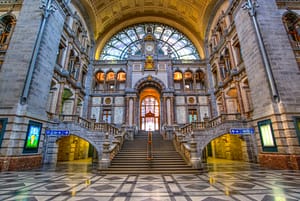The name ‘Antwerp’ came from a mythical giant named ‘antigoon’ who resided near the banks of the river Scheldt. He caused great distress to the residents of the city by extracting a toll for crossing the river, and those who revolted; he cut one of their hands and threw them in the Schedlt River. A hero named ‘Brabo’ finally laid the giant to rest by slaying him and threw one of his hands into the river. The name Antwerpen originated from the words ‘hand werpen’ which means ‘to throw’ in Dutch.
In the Golden era of 16th century, the city started maturing as the most economic and cultural hub in the world. After the decline of the Burgs in the 15th and 16th centuries, Antwerp became a major trading port. Ornate decorations, paintings, sculptures and silverware found in castles, churches and museums remind us of the glory of Antwerp’s rich heritage. In 1531 the world’s first specially built stock exchange opened here, and by 1555 Antwerp had become one of Europe’s main trading, cultural and intellectual centres, with a population of around 100,000.
But prosperity was ruthlessly cut short when Protestants smashed the city’s cathedral in 1566. Fanatically Catholic Spanish ruler Philip II sent troops to restore order, but 10 years later the unpaid garrison mutinied, themselves ransacking the city and massacring 8000 people. After further battles and sieges, Antwerp was finally incorporated into the Spanish Netherlands and force-fed Catholicism. Thousands of skilled workers headed north to the relative safety of the United Provinces.
Antwerp was occupied by Germany in October 1914 after weeks of heavy bombardment including aerial Zeppelin attacks. Around a million refugees left for the UK, France and the Netherlands, although most returned after 1918 to rebuild the city. In 1920 Antwerp hosted the Olympic Games and in 1928 construction began on Europe’s first skyscraper, the 27-storey Torengebouw. During WWII Antwerp’s port again made it an obvious military target, and during German occupation around two-thirds of the Jewish population perished. The city’s later 20th-century regeneration has been a sometimes contradictory mixture of modern multiculturalism and backlash, but few places seem so optimistic in forging ahead with 21st-century visions.
Today Antwerp is a major port, diamond exporter and a tourist attraction. Shopping streets, road side pubs and restaurants and a thriving nightlife of which many are open for 24 hours, magnetizes the tourists towards it.

